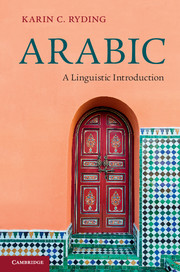Book contents
- Frontmatter
- Contents
- List of figures
- Preface
- Acknowledgments
- Abbreviations and symbols used in this book
- 1 Arabic linguistics: overview and history
- 2 Arabic phonology
- 3 Arabic phonotactics and morphophonology
- 4 Arabic syllable structure and stress
- 5 Introduction to Arabic morphology
- 6 Derivational morphology: the root/pattern system
- 7 Non-root/pattern morphology and the Arabic lexicon
- 8 Arabic inflectional morphology
- 9 Syntactic analysis and Arabic
- 10 Arabic syntax I: phrase structure
- 11 Arabic syntax II: clause structure
- Appendix A Fields of linguistics and Arabic
- Appendix B Arabic transcription/transliteration/romanization
- Appendix C Arabic nominal declensions
- Glossary of technical linguistic terms
- References
- Index
- References
10 - Arabic syntax I: phrase structure
Published online by Cambridge University Press: 05 June 2014
- Frontmatter
- Contents
- List of figures
- Preface
- Acknowledgments
- Abbreviations and symbols used in this book
- 1 Arabic linguistics: overview and history
- 2 Arabic phonology
- 3 Arabic phonotactics and morphophonology
- 4 Arabic syllable structure and stress
- 5 Introduction to Arabic morphology
- 6 Derivational morphology: the root/pattern system
- 7 Non-root/pattern morphology and the Arabic lexicon
- 8 Arabic inflectional morphology
- 9 Syntactic analysis and Arabic
- 10 Arabic syntax I: phrase structure
- 11 Arabic syntax II: clause structure
- Appendix A Fields of linguistics and Arabic
- Appendix B Arabic transcription/transliteration/romanization
- Appendix C Arabic nominal declensions
- Glossary of technical linguistic terms
- References
- Index
- References
Summary
Arabic phrase structure
Arabic syntactic study can be undertaken from several perspectives, as noted in the previous chapter. Phrases and clauses are the two key sites of syntactic analysis; phrases are organized groups of words that fill particular functions within sentences, but which also have a certain integrity and rule-structure of their own. Phrases have no predication (for example, haadhihi l-şuurat-u ‘this picture’ or al-bayt-u l-ʔabyađ-u ‘the white house’). Clauses (or sentences) involve a predication of some kind (for example, haadhihi hiya l-şuurat-u ‘This is the picture,’ or al-bayt-u ʔabyađ-u ‘The house is white’). This chapter focuses on Arabic phrase structure; the following chapter will focus on clause structure.
As noted earlier in the discussion of Arabic morphosyntax, the dominant principles of Arabic syntactic structure are agreement and government. These prevail in both phrase structure and clause structure, but in different ways. In this chapter I will first discuss agreement-based phrase structure and then government-based phrase structure.
- Type
- Chapter
- Information
- ArabicA Linguistic Introduction, pp. 119 - 126Publisher: Cambridge University PressPrint publication year: 2014



